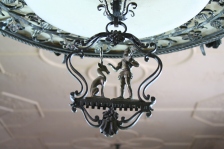Earlier this week, as part of our regularly scheduled inventory and evaluation of cultural properties, I took a specialist from Sotheby’s New York to see a painting a bit off the beaten track of Cranbrook’s usual spots to find art. Hanging in the Cranbrook Kingswood Middle School for Boys, A Hunter of Taos is an incredible work by the American painter Oscar Edmund Berninghaus.

A Hunter of Taos, 1926
Oscar Edmund Berninghaus, American, 1874-1952
Oil on canvas, 34 x 39 in.
Gift of Henry S. Booth to the Cranbrook School
The painting shows a male American Indian proudly standing with a bow and arrows, while horses and riders pass behind through a rocky landscape and trees aglow in warm sunlight. The trees are made up of swirling golds, ochres, and greens, their abstraction complimenting the almost impressionistic rendering of the figures immediately below. The central hunter, however, is rendered clearly, with his face set immediately in front of a draped white fabric and his gaze looking back at the viewer. The scale of the painting, about three-feet square, is impressive. But why is it here in the Boys Middle School, or even at Cranbrook?
First, let’s step back a bit further to the artist himself: Oscar Edmund Berninghaus (1874-1952). A native of St. Louis, he began his career as a commercial lithographer, draftsman, and illustrator. He explored painting as a fine art through classes at Washington University and at the St. Louis School of Fine Arts, where in 1899 the twenty-five year-old was awarded a month’s long paid journey westward by the Denver and Rio Grande Railroad. On this trip, Berninghaus was introduced to beauty and culture of the American Southwest, particularly Taos, New Mexico.
The Taos Pueblo, in north central New Mexico, is one of the oldest continuously inhabited places in North America, with the Pueblo people settling there over one-thousand years ago. It became a popular spot for artists in the late-1890s, and by 1910, Berninghaus was making annual pilgrimages between Taos and St. Louis. In the winter he would work on his lithography and commercial mural work to finance summers at Taos. There, he painted Native Americans, their horses, scenes of daily life, and the landscape. In 1915 he became a founding member of the Taos Society of Artists, composed of European-Americans who came to Taos to paint American Indian subjects. Berninghaus claimed he was “infected with the Taos germ” and was “fascinated by the people, the Indians and Mexicans, the adobe architecture, the sagebrush, the mountains; they all inspired me as a subject matter.”
In 1925, Berninghaus relocated permanently to Taos. He painted landscapes, animals, and scenes of daily life in the pueblo and village. In A Hunter of Taos, the model was Santiago Bernal, a Pueblo farm laborer and frequent model for Berninghaus. In a letter to a newspaper in 1927, Berninghaus wrote, “I think the colony in Taos is doing much for American Art. From it I think will come a distinctive art, something definitely American–and I do not mean that such will be the case because the American Indian and his environment are the subjects. But the canvases that come from Taos are as definitely American as anything can be. We have had French, Dutch, Italian, German art. Now we must have American art. I feel that from Taos will come that art” (as quoted in Pioneer Artists of Taos, p. 98).
Our painting, considered one of the artist’s finest, was first exhibited at New York’s National Academy of Design in its 1926 Winter Exhibition. The work won the Second Altman Prize, one of several awards given out by the Academy of Design. On June 6, 1927, Henry Booth purchased the painting from the artist.

View of A Hunter of Taos in the North Lobby, Hoey Hall, Cranbrook School. 1928. Peter A. Nyholm, Photographer. Cranbrook Archives.
After Booth purchased the work, the painting hung in the north lobby of Hoey Hall for the opening of Cranbrook School for Boys in September of 1927. Henry formally presented the painting to Cranbrook School on October 18, 1927. In the last half of the century, the painting was moved to the new Cranbrook Kingswood Middle School for Boys, where it hangs in a small lobby for administrative offices. Examining the painting Tuesday, we saw it is in excellent condition, and I appreciated that it’s in a spot where many young men and their parents have a chance to sit and appreciate it. It’s one of the great assets of Cranbrook that the campus is sprinkled with great art in all of our buildings—I think it’s a big part of what makes this place so magical.
– Kevin Adkisson, Collections Fellow, Cranbrook Center for Collections and Research
NB: If you want to learn about another Cranbrook connection to the Southwest and the Pueblo people, revisit this excellent post on Amelia Elizabeth White and her gift of Native American art and artifacts to the Cranbrook Institute of Science in 1937.




























